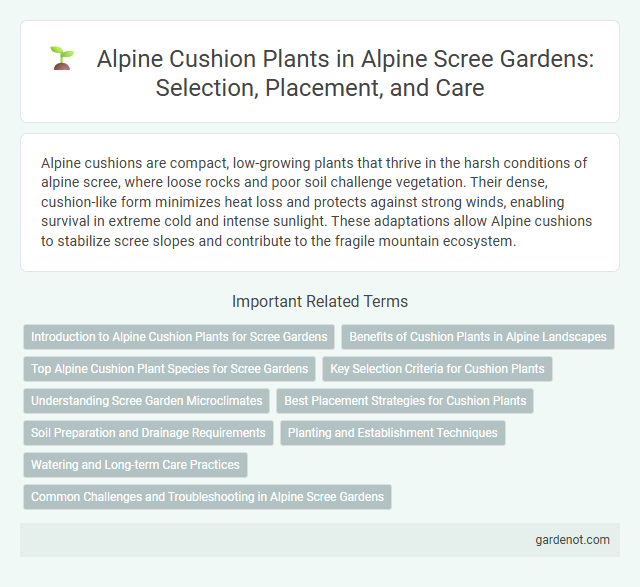Alpine cushions are compact, low-growing plants that thrive in the harsh conditions of alpine scree, where loose rocks and poor soil challenge vegetation. Their dense, cushion-like form minimizes heat loss and protects against strong winds, enabling survival in extreme cold and intense sunlight. These adaptations allow Alpine cushions to stabilize scree slopes and contribute to the fragile mountain ecosystem.
Introduction to Alpine Cushion Plants for Scree Gardens
Alpine cushion plants are specialized species adapted to thrive in harsh scree environments, characterized by rocky, unstable substrates and extreme temperature variations. These low-growing, compact plants reduce exposure to wind and conserve moisture, making them ideal for scree gardens that mimic high-altitude conditions. Incorporating alpine cushion plants such as Silene acaulis and Saxifraga oppositifolia enhances biodiversity and adds vibrant texture to alpine scree landscapes.
Benefits of Cushion Plants in Alpine Landscapes
Cushion plants in alpine scree enhance soil stability by reducing erosion through their dense, mat-like growth, which traps moisture and organic matter. These plants create microhabitats that support biodiversity by providing shelter and nutrients for invertebrates and other alpine species. Their ability to withstand harsh conditions contributes to ecosystem resilience and promotes succession in challenging alpine environments.
Top Alpine Cushion Plant Species for Scree Gardens
Top Alpine cushion plant species for scree gardens include Silene acaulis, Saxifraga oppositifolia, and Androsace alpina, known for their dense, low-growing mats that stabilize rocky substrates. These species exhibit exceptional drought resistance and cold tolerance, adapting well to the harsh, nutrient-poor conditions typical of alpine scree environments. Their compact growth form reduces wind exposure and conserves moisture, making them ideal for creating sustainable, low-maintenance alpine garden landscapes.
Key Selection Criteria for Cushion Plants
Alpine cushion plants demonstrate exceptional resilience due to their compact growth form, which minimizes exposure to harsh winds and retains heat in cold environments. Key selection criteria for cushion plants include tolerance to extreme temperature fluctuations, efficient water retention capabilities, and the ability to thrive in nutrient-poor, rocky substrates characteristic of alpine scree. These adaptations enhance survival and ecological function in the high-altitude alpine ecosystem.
Understanding Scree Garden Microclimates
Alpine cushion plants create sheltered microclimates within scree gardens by reducing wind exposure and stabilizing temperature fluctuations, which supports diverse plant and microbial communities. These dense, low-growing mats retain moisture more effectively than surrounding scree, promoting soil development and nutrient cycling in otherwise harsh conditions. Understanding these microclimates is crucial for conservation and restoration efforts in alpine scree ecosystems, where microhabitat variability drives species survival.
Best Placement Strategies for Cushion Plants
Alpine cushion plants thrive best in well-drained scree slopes with southern sun exposure, where microclimatic conditions reduce frost damage and waterlogging. Optimal placement involves positioning these cushions in sheltered nooks or crevices to protect against harsh winds while maximizing sunlight absorption. Ensuring proximity to rocky substrates enhances root anchorage and nutrient uptake, promoting healthier growth in alpine scree environments.
Soil Preparation and Drainage Requirements
Alpine cushion plants require well-drained, rocky or sandy soils that mimic their natural scree habitat to prevent root rot and ensure healthy growth. Soil preparation involves creating a gritty, low-fertility substrate rich in mineral content with excellent drainage properties to support these drought-tolerant species. Proper site selection and the incorporation of coarse sand or gravel enhance soil aeration and water runoff, crucial for maintaining the delicate balance of moisture preferred by alpine cushions.
Planting and Establishment Techniques
Alpine cushion plants require well-drained, rocky substrates mimicking natural scree environments to ensure proper root development and moisture balance. Planting techniques emphasize careful placement in crevices or shallow pits with minimal disturbance to existing soil layers, enhancing stability and root anchorage. Establishing these plants benefits from slow acclimatization to sun exposure and protection from excessive moisture to prevent rot and encourage healthy growth.
Watering and Long-term Care Practices
Alpine cushions require precise watering schedules to maintain moisture without waterlogging, ideally using drip irrigation for deep soil hydration. Long-term care involves well-drained, rocky substrates and minimal disturbance to root systems to encourage healthy growth and prevent fungal diseases. Regular monitoring of soil moisture and occasional feeding with low-nitrogen fertilizers supports sustained vitality of Alpine cushion plants.
Common Challenges and Troubleshooting in Alpine Scree Gardens
Alpine cushion plants in scree gardens often face challenges such as poor drainage and soil instability, which can lead to root rot and hinder healthy growth. Maintaining well-drained, gritty soil with adequate mineral content is crucial to prevent these issues. Regular monitoring for pests like aphids and addressing nutrient deficiencies through appropriate fertilization optimize plant resilience and aesthetic appeal.
Alpine cushion Infographic

 gardenot.com
gardenot.com